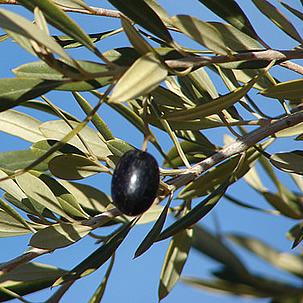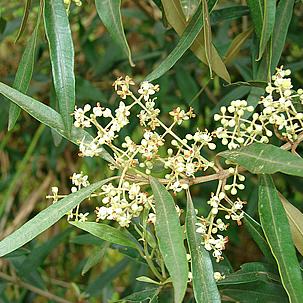The Olive Tree (Olea europaea) is an evergreen, long-lived, fruit-bearing, and ornamental tree native to the Mediterranean region. From it, we obtain olives and the precious olive oil, which humans learned to extract in the Neolithic Period, around 10,000 B.C., for use as food, fuel, and ointment, making the olive tree revered by many peoples. They are trees of extreme longevity, reaching up to 2,500 years of age.
Its size is small, rarely exceeding 10 meters (approximately 33 feet) in height, with a wide, rounded crown, and a thick, irregular, gray, and quite twisted trunk, resembling our cerrado trees. The roots are strong and can reach a depth of 6 meters (about 20 feet). The leaves are elliptical to lanceolate, acuminate, opposite, with a grayish-green color on the upper surface and silver on the lower surface, giving the foliage a bluish appearance. Inflorescences appear in the spring, in the leaf axils, and are panicle-type, with numerous cream-white flowers, emitting a gentle fragrance.
The flowers are hermaphroditic and can self-pollinate in most varieties. Pollination is done by the wind. In autumn, olives, a drupe-type fruit, ellipsoid, with fleshy, juicy pulp containing a seed, the pit, are formed. The main difference between green and black olives is the harvest time, with green ones being harvested immature and black ones when they are already ripe, resulting in distinct flavors in preservation. There are hundreds of olive varieties, with different adaptive qualities to cultivation locations, larger or smaller fruits, among other characteristics.

In landscaping, olive trees have been used for millennia. They are very versatile, robust, and require low maintenance. They can be used individually as highlights or in the formation of hedges and groves. Both the trunk with an aged appearance and the bluish crown create significant interest, not to mention the beautiful effect of fruiting.
They are also suitable for topiaries and container use. Currently, due to their great resistance to transplantation, many centuries-old olive trees from ancient plantations are being used as ornamentals in gardens, usually in prominent positions, highlighting the sculptural forms of the trunks shaped by time. The growth of the olive tree is quite slow, making the planting of larger seedlings advantageous when a quick garden effect is desired. Due to this fact, larger specimens fetch high prices in the market. It is also widely used in bonsai practice. Fun fact: Olive trees are the most cultivated fruit-bearing trees worldwide.

It should be cultivated in full sun, in well-drained, poor or fertile soils, and irrigated in the first year of establishment. The olive tree is very robust and can withstand long periods of drought; however, supplementary irrigation is advisable if the dry period occurs during flowering, thus avoiding a sudden drop in olive production.
It tolerates a wide climatic range, thriving in temperate or tropical climates. Frost, however, can adversely affect fruiting. It withstands drastic pruning, regenerating easily. In productive orchards, it is essential to perform formative, cleaning, and foliage renewal pruning, thereby increasing productivity, vitality, and improving the harvest. It can be planted in coastal areas as it tolerates strong winds and salinity.
The weak point of the olive tree is excess moisture. Soils prone to waterlogging lead to the rapid decline of the tree, making it fragile and susceptible to fungal diseases. It easily multiplies through semi-hardwood cuttings, preferably leafless, planted to root at the end of summer. It also propagates through air layering, grafting, and seeds.


